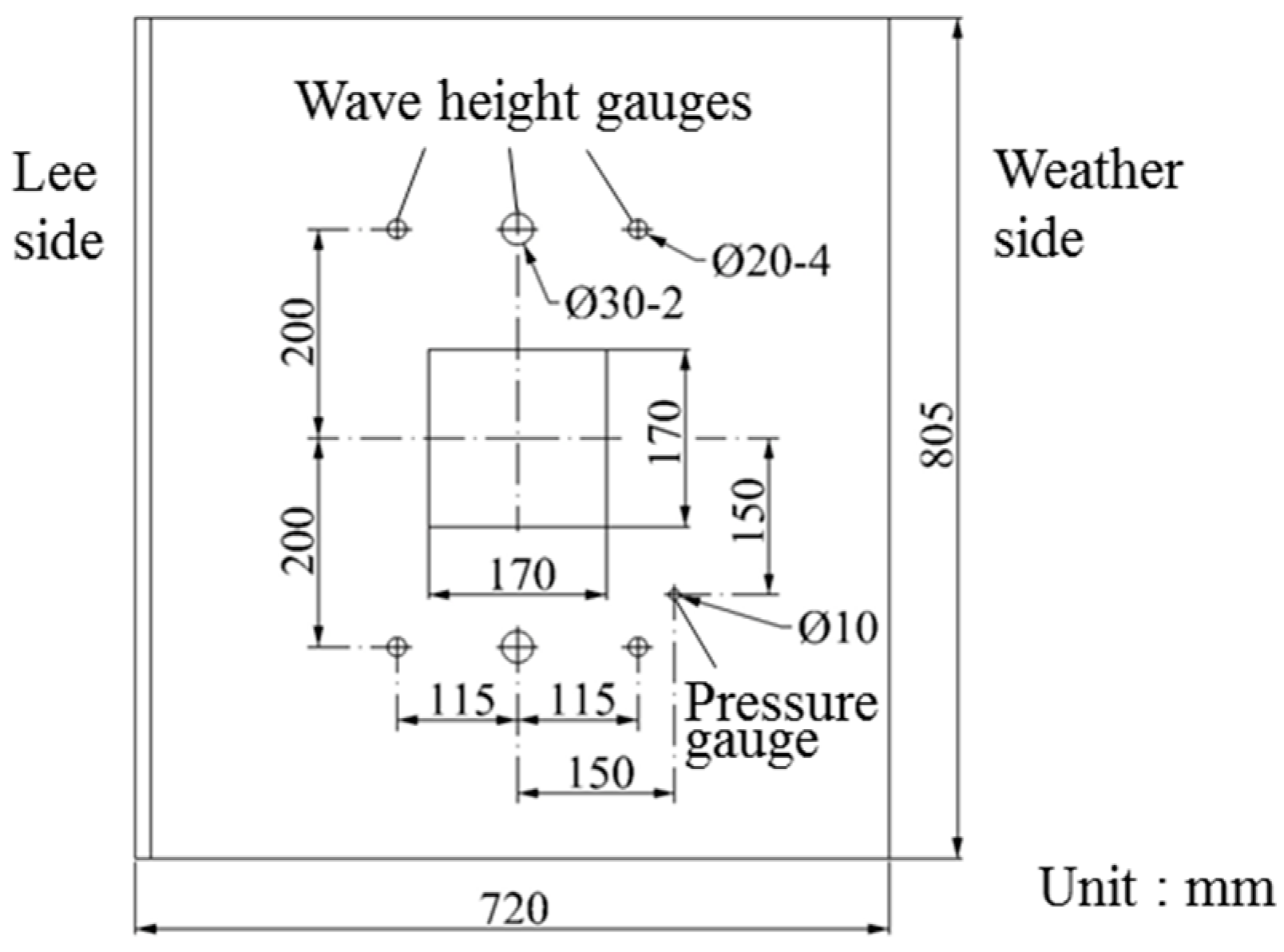Experimental Research on Primary and Secondary Conversion Efficiencies in an Oscillating Water Column-Type Wave Energy Converter
Abstract
:1. Introduction
2. Experimental Apparatus
3. Steady Air Flow Test
4. Oscillating Air Flow Tests by Water Waves
4.1. Effect of Air Chamber Length
4.2. Effect of Setting Angle of the Guide Vane
5. Conclusions
- (1)
- The reflected wave is suppressed by changing the chamber length from L = 0.5 m to 0.7 m, resulting in the achievement of the high primary conversion efficiency;
- (2)
- Almost the same high generating efficiency is achieved in the two cases of L = 0.7 m and 0.9 m because the reflection coefficient is equally low;
- (3)
- The effect of the setting angle θ of the guide vane on the primary conversion efficiency is small, within the range of θ = 22.5 degrees to 37.5 degrees;
- (4)
- The recommended setting angle of the guide vane is θ = 30 degrees in the case of the rotor inlet/outlet angle γ = 60 degrees.
Acknowledgments
Author Contributions
Conflicts of Interest
References
- Falcão, A.F.O. Wave Energy Utilization: A Review of the Technologies. Renew. Sustain. Energy Rev. 2010, 14, 899–918. [Google Scholar] [CrossRef]
- Lasa, J.; Antolin, J.C.; Angulo, C.; Estensoro, P.; Santos, M.; Ricci, P. Design, Construction and Testing of a Hydraulic Power Take-off for Wave Energy Converters. Energies 2012, 5, 2030–2052. [Google Scholar] [CrossRef] [Green Version]
- Mehrangiz, S.; Emami, Y.; Sadigh, S.H.S.; Etemadi, A. Various Technologies for Producing Energy from Wave: A Review. Int. J. Smart Grid Clean Energy 2013, 2, 289–294. [Google Scholar] [CrossRef]
- Cameron, L.; Doherty, R.; Henry, A.; Doherty, K.; Van’t Hoff, J.; Kaya, D.; Naylor, D.; Bourdier, S.; Whittaker, T. Design of the Next Generation of the Oyster Wave Energy Converter. In Proceedings of the 3rd International Conference on Ocean Energy, Bilbao, Spain, 6–8 October 2010; pp. 1–12.
- Vicinanza, D.; Margheritini, L.; Kofoed, J.P.; Buccino, M. The SSG Wave Energy Converter: Performance, Status and Recent Developments. Energies 2012, 5, 193–226. [Google Scholar] [CrossRef]
- Falcão, A.F.O.; Henriques, J.C.C. Oscillating-Water-Column Wave Energy Converters and Air Turbines: A Review. Renew. Energy 2016, 85, 1391–1424. [Google Scholar] [CrossRef]
- Henriques, J.C.C.; Gomes, R.P.F.; Gato, L.M.C.; Falcão, A.F.O.; Roble, E.; Ceballos, S. Testing and Control of a Power Take-off System for an Oscillating-water-column Wave Energy Converter. Renew. Energy 2016, 85, 714–724. [Google Scholar] [CrossRef]
- Ning, D.; Wang, R.; Zou, Q.; Teng, B. An Experimental Investigation of Hydrodynamics of a Fixed OWC Wave Energy Converter. Appl. Energy 2016, 168, 636–648. [Google Scholar] [CrossRef]
- Toyota, K.; Nagata, S.; Imai, Y.; Setoguchi, T. Effects of Hull Shape on Primary Conversion Characteristics of a Floating OWC “Backward Bent Duct Buoy”. J. Fluid Sci. Technol. 2008, 3, 458–465. [Google Scholar] [CrossRef]
- Nagata, S.; Toyota, K.; Imai, Y.; Setoguchi, T.; Mamum, M.A.H. Numerical Analysis on Primary Conversion Efficiency of Floating OWC-Type Wave Energy Converter. In Proceedings of the Twenty-First International Offshore and Polar Engineering Conference, Maui, HI, USA, 19–24 June 2011; pp. 578–585.
- Takahashi, S.; Ojima, R.; Suzumura, S. Air Power Pneumatic-Type Wave Power Extractors Due to Irregular Wave Actions—A Study on Development of Wave Power, 3rd Report. Port Harb. Res. Inst. 1985, 24, 3–41. [Google Scholar]
- Takahashi, S.; Nakada, H.; Ohneda, H.; Shikamori, M. Wave Power Conversion by a Prototype Wave Power Extracting Caisson in Sakata Port. Coast. Eng. 1992, 3440–3453. [Google Scholar] [CrossRef]
- Lin, C.C.; Dorrell, D.G.; Hsieh, M. A Small Segmented Oscillating Water Column Using a Savonius Rotor Turbine. In Proceedings of the IEEE International Conference on Sustainable Energy Technologies (ICSET), Singapore, 24–27 November 2008; pp. 508–513.
- Liu, Z.; Hyun, B.; Hong, K. Application of Numerical Wave Tank to OWC Air Chamber for Wave Energy Conversion. In Proceedings of the Eighteenth International Offshore and Polar Engineering Conference, Vancouver, BC, Canada, 6–11 July 2008; pp. 350–356.
- Korde, U.A. Development of a Reactive Control Apparatus for a Fixed Two-dimensional Oscillating Water Column Wave Energy Device. Ocean Eng. 1991, 18, 465–483. [Google Scholar] [CrossRef]
- Setoguchi, T.; Santhakumar, S.; Maeda, H.; Takao, M.; Kaneko, K. A Review of Impulse Turbines for Wave Energy Conversion. Renew. Energy 2001, 23, 261–292. [Google Scholar] [CrossRef]
- Setoguchi, T.; Takao, M. Current Status of Self Rectifying Air Turbines for Wave Energy Conversion. Energy Convers. Manag. 2006, 47, 2382–2396. [Google Scholar] [CrossRef]
- Takao, M.; Setoguchi, T. Air Turbines for Wave Energy Conversion. Int. J. Rotating Mach. 2012, 2012, 717398. [Google Scholar] [CrossRef]
- Goda, Y.; Suzuki, Y. Estimation of Incident and Reflected Waves in Random Wave Experiments. Coast. Eng. 1976, 828–845. [Google Scholar] [CrossRef]
- Koirala, P.; Nagata, S.; Imai, Y.; Murakami, T. A Numerical Study on Multi-chamber Oscillating Water Columns. J. Jpn. Soc. Civ. Eng. 2015, 3, 93–104. [Google Scholar] [CrossRef]













© 2016 by the authors; licensee MDPI, Basel, Switzerland. This article is an open access article distributed under the terms and conditions of the Creative Commons Attribution (CC-BY) license (http://creativecommons.org/licenses/by/4.0/).
Share and Cite
Murakami, T.; Imai, Y.; Nagata, S.; Takao, M.; Setoguchi, T. Experimental Research on Primary and Secondary Conversion Efficiencies in an Oscillating Water Column-Type Wave Energy Converter. Sustainability 2016, 8, 756. https://doi.org/10.3390/su8080756
Murakami T, Imai Y, Nagata S, Takao M, Setoguchi T. Experimental Research on Primary and Secondary Conversion Efficiencies in an Oscillating Water Column-Type Wave Energy Converter. Sustainability. 2016; 8(8):756. https://doi.org/10.3390/su8080756
Chicago/Turabian StyleMurakami, Tengen, Yasutaka Imai, Shuichi Nagata, Manabu Takao, and Toshiaki Setoguchi. 2016. "Experimental Research on Primary and Secondary Conversion Efficiencies in an Oscillating Water Column-Type Wave Energy Converter" Sustainability 8, no. 8: 756. https://doi.org/10.3390/su8080756





